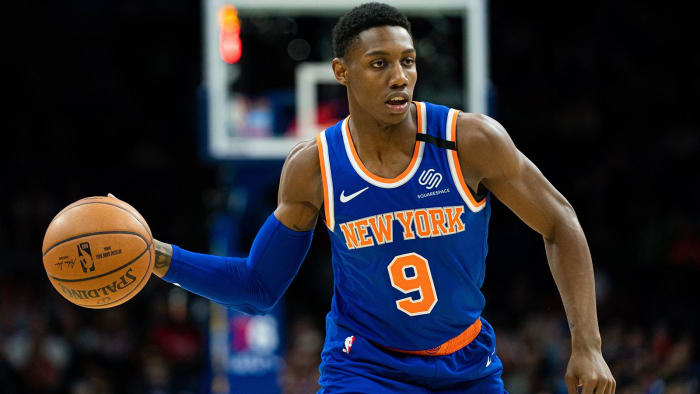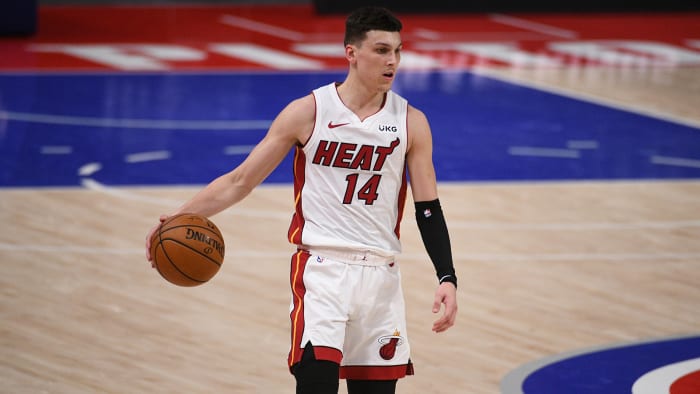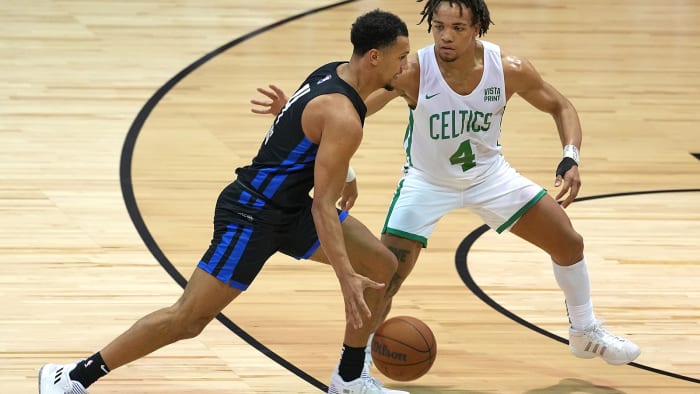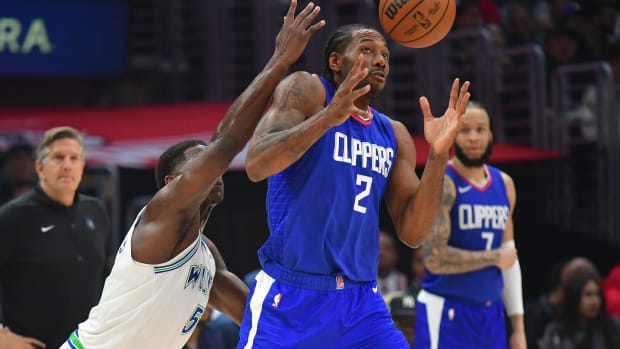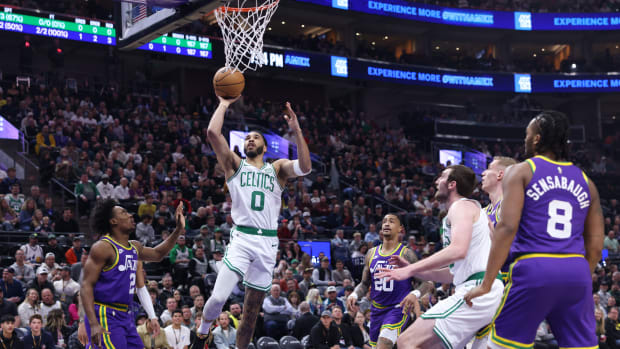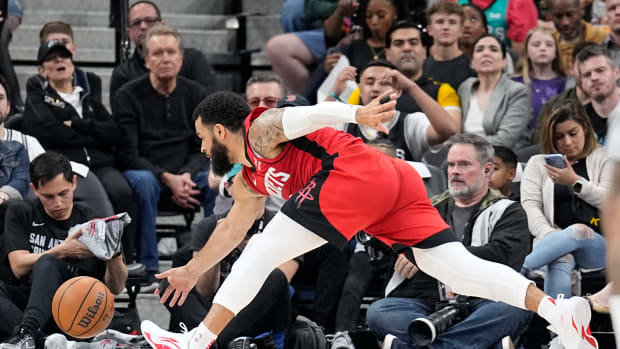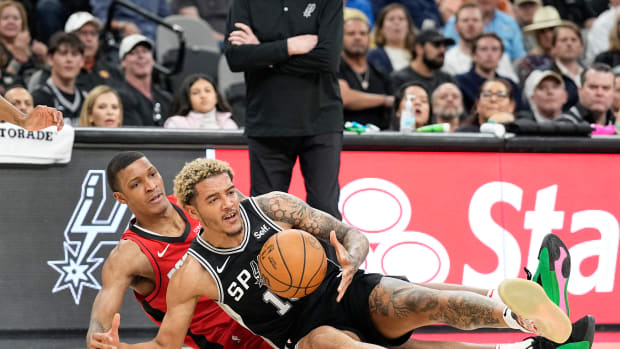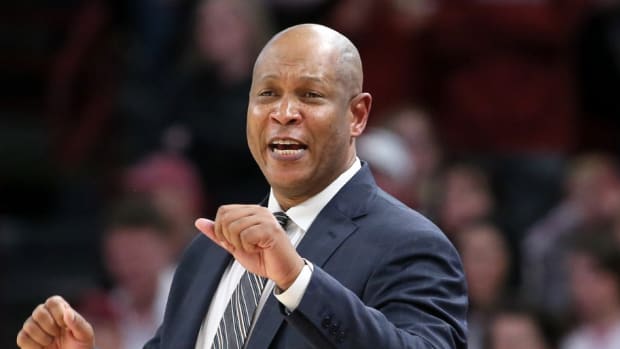Top 100 NBA Players of 2022: Watch List
By nature, SI’s Top 100 list naturally favors older, established talent—it’s an assessment of projected short-term quality and contributions, and not what a player may accomplish in the future. The Watch List, which is what you are currently reading, is meant as an annual catch-all for the most promising young prospects who miss the cut. These are all players who could find their way onto the Top 100 in the near future.
For the sake of differentiation, the methodology here is a bit different this year: This list includes players entering only their first, second or third years in the league, and those players were not considered for the snubs list (suffice it to say that patience is always helpful when it comes to young talent). Any player with longer tenure than that was considered for the snubs list. It’s all very arbitrary. Also note that as a rule of thumb, rookies are purposefully excluded from Top 100 discussions each year.
The league is rife with young talent right now, and the watch list expanded to 16 names this year in an attempt to be inclusive. Players are listed alphabetically.
Barrett made promising improvements as a spot-up player last season, and maintaining the ability to threaten with his jumper and attack closeouts is key. There were two big knocks on him as a prospect: He added minimal value without the ball in his hands, and often had tunnel vision while hunting shots. Next on the list is becoming a more efficient interior scorer, as Barrett went to the rim frequently but finished in just the 18th percentile for league-wide scoring around the basket (and shot just 46% on those attempts, per Synergy). New Knicks Kemba Walker and Evan Fournier should make his life easier. Barrett is known as a hard worker, which has already borne noticeable fruit, and if his game expands meaningfully, the Top 100 is within reach.
Scottie Barnes, Toronto Raptors
Barnes has historically added intrinsic value with his presence on the court, boasting innate toughness and versatility the Raptors believe will translate. His competitive nature and immense wingspan could eventually make him one of the better frontcourt defenders in the league. He’s a terrific passer, and not just for his size. It’s the progression of Barnes’s individual offense that will determine what he becomes in the NBA: He’s not a good jump shooter yet, and doesn’t have much bread or butter as a scorer beyond converting random offense. Barnes has always been unique, and his progression into an eventual starter in Toronto may be unorthodox. Give him a few years.
Cade Cunningham, Detroit Pistons
If all goes according to plan, the No. 1 pick in the 2021 draft won’t have to wait long to make his Top 100 debut. Cunningham is as advanced a thinker of the game as any top pick in recent memory, and while he’s greatly sharpened his jumper and scoring acumen over the past year, what makes him special is his ability to accentuate teammates and supervise game flow. The Pistons will likely ease him into full-time lead guard duties, and don’t expect him to lead a one-man revolution, but by the end of his rookie year, Cunningham’s best qualities should be obvious. It now falls on Detroit to put the best possible ecosystem around him.
Darius Garland, Cleveland Cavaliers
Garland made nice strides in his sophomore season, and it may not be long at all before he surpasses Collin Sexton as his team’s most valuable young guard. He’s a naturally crafty, pacy attacker who can create plays for teammates, and already a quality jump shooter. The learning curve for lead guards to anchor winning teams can be steep, but that progression should be aided by Cleveland’s additions of Evan Mobley and Jarrett Allen, two quality defensive bigs. Garland has battled injuries and hasn’t quite put it all together yet, but that day is coming. His development is central to any progress the Cavs make this season.
Jalen Green, Houston Rockets
Volume-reliant scorers have historically faced a longer pathway to a spot on our Top 100 list, but Green may be special enough to make the leap rather quickly. His time in the G League greatly improved his understanding of shot selection, and his speed and explosiveness will immediately make him a tough cover. It’s just that finding the intersection of volume and efficiency is nearly always a hurdle for prospects in his mold, which means patience is warranted. The Rockets won’t win many games this year, and Green’s defense is going to be a work in progress. Still, he’s been a quick learner, and it won’t be shocking if he looks like Houston’s best player six months from now. When Green has it going on offense, he makes everything look easy.
Josh Giddey, Oklahoma City Thunder
Giddey’s climb to No. 6 in this year’s draft came thanks to a tremendously encouraging year in his native Australia, where he won NBL Rookie of the Year, led the league with 7.6 assists per game, and recorded three triple doubles in 28 games—all at the age of 18. That’s outlier-level stuff, and while success may not come as quickly for what will again be one of the NBA’s worst teams, the Thunder will have nothing but patience. Whether Giddey evolves into a viable lead guard or becomes more of a secondary playmaking wing at 6' 8", there are multiple pathways for him to eventually crack the Top 100, so long as his jumper keeps improving.
This is Herro’s second straight season on the watch list, which is perfectly fine, as the expectations foisted on him after a strong showing in the Orlando bubble were always a tad outlandish. He’s still ahead of schedule relative to what he showed in college, with his shotmaking skills, pick-and-roll acumen, and general gusto making him one of the NBA’s more unique young guards. Herro will likely never add much defensively but has enough creativity to his game that the positive may eventually outweigh the negative. But it will take additional all-around improvement for him to crack the list, and a real uptick in overall efficiency for him to scale it.
Keldon Johnson, San Antonio Spurs
Johnson’s growth in Year 2 was a major bright spot for the rebuilding Spurs: He spent most of his rookie year in the G League and made just six NBA appearances before the 2020 bubble, where he became a regular and eventually earned a starting job as a sophomore. Johnson’s heart has always been in the right place, and he’s always played extremely hard, which paid off in solid per-minute production last season and a bench spot on the U.S. Olympic team. He needs to expand his game as a passer, he’s not overly tall for his position and his shot has to improve, so he projects better as a long-term supporting piece than as a future star. San Antonio will let him play through mistakes, and will be a great place for him to keep figuring things out.
Watch NBA games online all season long with fuboTV: Start with a 7-day free trial!
Jonathan Kuminga, Golden State Warriors
Rookie expectations for Kuminga have to be somewhat tempered, as he’ll face an adjustment to a complementary role for a Golden State team facing playoff pressure. He walks into the league with a legitimate physical advantage at his size, and should be effective to some extent as a slasher right away. Kuminga’s decision-making skills, jumper and defensive investment will all require nourishment from his coaching staff, but his athletic toolbox will help him see the floor. His development is a big factor in the Warriors’ future, but they could also use some help from him in the present. We’ll see how quick a learner he is, and the upside with Kuminga as a starting-caliber forward remains rather high.
Evan Mobley, Cleveland Cavaliers
While Mobley may struggle a bit with the physicality of the NBA as a rookie, he’s an excellent long-term bet to become one of the league’s more versatile bigs. He’s a gifted shot blocker with great length and can cover space effectively despite his lack of physical strength. He has legitimate ball skills and shooting potential on the other end. The Cavaliers will have to figure out how to best optimize him in the early going, but Mobley has been a highly impactful player at every stop. He should offer legit defensive backbone and offensive optionality and impact winning positively, even if he’s something less than a true go-to guy in the long run.
Chuma Okeke, Orlando Magic
Call this one a personal hunch: The 23-year-old Okeke hasn’t done much in the NBA yet, missing his rookie year due to injury and playing a small role for the Magic last year. But he was pretty effective after stepping in as a starter in April, exhibiting the 3-and-D acumen that made him such an intriguing prospect in college. As Okeke enters the season with a clean bill of health, we should get a much better sense of what he’s capable of. There’s real upside here.
Kevin Porter Jr., Houston Rockets
For better or worse, Porter is one of the bigger wild cards in the NBA: He was run out of Cleveland after a series of off-court issues, went to Houston for nothing, lit it up in the G League and finished the season with the Rockets, where he averaged 16.6 points and 6.3 assists in 26 games. He also hung a stunning 50-point, 11-assist effort on the Bucks in April. Porter’s athleticism and individual skills have never really been in question, and he’s still just 21 years old, but it’s the other stuff that’s held him back. After tearing their roster down and entering a growth phase, the Rockets are going to let him figure it out. And if Porter can stay focused and keep his career on track, his upside is still pretty real.
Alperen Sengun, Houston Rockets
As strange a player as he is, it was hard to omit Sengun from this list based on his trajectory over the past year or so. He was relatively unknown before he lit up the Turkish League at 18, playing his way into the first round. Then, he was terrific at Summer League, finding ways to produce in the paint whether or not you throw him the ball. Sengun is a terrific finisher and passer with more defensive toughness than he gets credit for, and his average athleticism and positional size haven’t held him back much to this point. If the sheer productivity continues to translate, it’ll get tougher to ignore, and what he’s accomplished to this point is highly unusual for a player his age.
Jalen Suggs, Orlando Magic
It’s hard to envision a scenario where Suggs doesn’t make an All-Rookie team this season, given how hard he plays, and how bankable his production tends to be. He may not be a dominant individual scorer in the NBA, but his elite athletic gifts, unselfishness and defensive mentality allow him to impact game flow in myriad facets. To become a high-usage scorer, he’ll need to sharpen his jumper and ball skills. Even if that never happens, Suggs’s infectious motor and well-rounded game give him a neat pathway to value, and make him likely to accessorize winning. By the end of his rookie year, he could be Orlando’s most impactful guard.
Patrick Williams, Chicago Bulls
The Bulls were enamored with Williams for good reason, and he was better than generally expected as a rookie, starting all 71 of his games and receiving a crash course in the pace and physicality of the NBA. That should pay off in spades as ........Chicago pushes for the playoffs, and the addition of DeMar DeRozan and Lonzo Ball should open up the floor for Williams to make plays and attack defenses with a preordained advantage. His size and versatility are pretty much the prototype for today’s combo forward, and he’s still only 20, with a long runway to make it all click. At worst, he should become a plus 3-and-D option, which could put him squarely in the Top 100 convo. He could also very well be more than that.
James Wiseman, Golden State Warriors
Wiseman faced unenviable pressure from every direction last season: After playing just three games in college and basically spending a year away from basketball that was eventually beset by a pandemic, he was drafted by a team with playoff hopes and a hole at his position, and went one spot before the eventual Rookie of the Year. He was always going to struggle as a rookie; it certainly didn’t have to be painted as abject failure. But the magnifying glass was hot. Golden State still needs a lot from Wiseman this season, and he’ll need to show much more aptitude for his role to be a difference-maker. He still has the capacity to be one of the league’s better bigs, but his trajectory has certainly been less than optimal to this point. It’ll take some resilience for him to turn it around.
More NBA Coverage:
- SI Top 100: Counting Down 100-51
- SI Top 100: Counting Down 50-31
- SI Top 100: Counting Down 30-11
- SI Top 100: Counting Down 10-1
- SI Top 100: Biggest Snubs
Sports Illustrated may receive compensation for some links to products and services on this website.






























